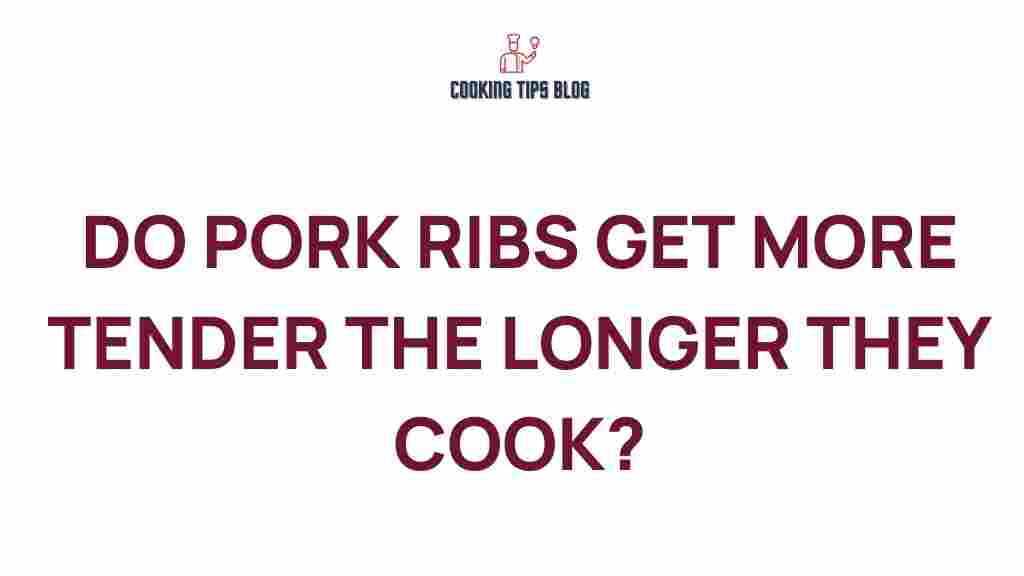Pork Ribs: Do They Get More Tender with Time?
When it comes to cooking meats, few dishes are as beloved as a succulent rack of pork ribs. The tenderness and flavor of pork ribs can elevate any meal, making them a sought-after dish at barbecues, family gatherings, and restaurants alike. However, a common question arises: do pork ribs get more tender with time? In this article, we will unravel this mystery by exploring the science behind meat tenderness, cooking methods, and the ideal ways to prepare pork ribs for optimum flavor and texture.
Understanding Meat Tenderness
Before we delve into the specifics of pork ribs, it’s essential to understand what makes meat tender. Tenderness in meat is influenced by various factors, including:
- Muscle Composition: Different cuts of meat come from different parts of the animal, which affects their tenderness. For instance, tougher muscles, which are used more frequently, tend to be less tender.
- Age of the Animal: Generally, younger animals produce more tender meat.
- Cooking Method: How meat is cooked can greatly impact its tenderness. Slow cooking methods often yield more tender results.
- Marination: Acidic marinades can help break down muscle fibers, resulting in more tender meat.
Now, let’s focus on pork ribs specifically and investigate if they get more tender with time as they are cooked or stored.
Do Pork Ribs Get More Tender as They Cook?
The short answer is yes, pork ribs do get more tender as they cook, but there’s a bit more to consider:
- Cooking Time: The longer pork ribs are cooked, the more tender they become. This is particularly true for tougher cuts like spare ribs, which benefit from low and slow cooking methods.
- Collagen Breakdown: Pork ribs contain collagen, a connective tissue that breaks down into gelatin when cooked for a long time. This process enhances tenderness and adds a rich flavor.
- Temperature: Cooking at low temperatures (around 225°F to 250°F) allows collagen to break down gradually, leading to juicy and tender ribs.
For optimal results, consider using a smoker or slow cooker to maximize the tenderness of your pork ribs.
Cooking Methods for Tender Pork Ribs
Here are several popular cooking methods that can help you achieve tender pork ribs:
1. Smoking
Smoking pork ribs is a traditional method that allows the meat to cook slowly while absorbing smoky flavors. Here’s how to do it:
- Preparation: Remove the membrane from the back of the ribs and apply a dry rub.
- Set Up the Smoker: Preheat your smoker to 225°F. Use wood chips like hickory or applewood for added flavor.
- Cooking Time: Place the ribs in the smoker and cook for 4-6 hours, spritzing them with apple juice or vinegar every hour to keep them moist.
- Wrapping: After 3 hours, wrap the ribs in foil to help steam and tenderize them further.
2. Braising
Braising pork ribs can also produce remarkably tender results. This method combines both dry and moist heat. Here’s a simple braising technique:
- Brown the Ribs: Sear the ribs in a hot pan until browned on all sides.
- Add Liquid: Transfer the ribs to a Dutch oven, add broth, vinegar, or your favorite sauce, and cover.
- Cook Slowly: Place the Dutch oven in a preheated oven at 300°F and cook for 2-3 hours until tender.
3. Grilling
While grilling is typically quicker, you can still achieve tender ribs if done correctly:
- Indirect Heat: Set up your grill for indirect cooking by placing the ribs away from direct flames.
- Cook Low and Slow: Grill at around 250°F, flipping occasionally and basting with sauce to enhance moisture.
- Finish on Direct Heat: For the last few minutes, move the ribs over direct heat to caramelize the sauce.
Storing and Reheating Leftover Pork Ribs
If you have leftover pork ribs, proper storage and reheating can also affect tenderness. Here are some tips:
- Storage: Store leftover ribs in an airtight container in the refrigerator for up to 4 days. For longer storage, freeze them wrapped tightly in plastic wrap and aluminum foil.
- Reheating: Reheat ribs in the oven at 250°F for about 30 minutes. This gentle reheating allows them to retain moisture and tenderness.
Troubleshooting Tips for Tender Pork Ribs
Even with the best intentions, you might find your pork ribs aren’t as tender as you’d like. Here are some troubleshooting tips:
- Too Tough: If your ribs are tough, they may need more cooking time. Consider wrapping them in foil and cooking them longer.
- Dry Ribs: If ribs come out dry, they may have been cooked at too high a temperature. Always aim for low and slow cooking.
- Flavor Issues: If the ribs lack flavor, ensure you use a good marinade or rub, and consider basting them during cooking.
Conclusion
In conclusion, pork ribs do indeed get more tender with time when cooked properly. Understanding the factors that influence meat tenderness, choosing the right cooking methods, and taking care of leftovers can significantly enhance your pork rib experience. Whether you opt for smoking, braising, or grilling, patience and technique will yield delicious, tender results. So fire up the grill or smoker, and enjoy a plate of mouthwatering pork ribs that will surely impress your family and friends!
For more tips on cooking techniques, check out this helpful resource on cooking meat. Happy cooking!
This article is in the category Recipes and created by Cookingtipsblog Team
